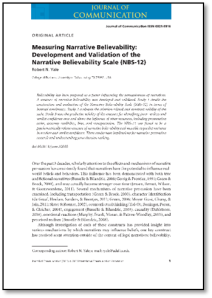Research
As a researcher, my training and primary area of scholarly interest is in strategic message design and analysis. My research to date has concerned three broad areas of this interest: factors influencing the persuasiveness of messages, the effectiveness of pro-social marketing campaigns, and the development and validation of measures to assist researchers of the first two areas.
Specifically, my research seeks to understand the factors that make messages persuasive (or not persuasive) to different segments of consumers and message recipients. Current research investigates the mechanisms within narrative messages that render them more or less persuasive (e.g., Yale, 2013) and individual difference variables that influence message processing, such as brand schematicity, need for cognition, and psychological reactance.
Narrative Believability
 Past research has identified characteristics of narratives that determine the effectiveness of a narrative for influencing attitudes, beliefs, and behaviors. My dissertation research involved the development and validation of a measure of narrative believability based on four of these constructs: coverage, consistency, completeness, and plausibility. In the first study, undergraduate students (N = 474) read two narratives and completed a survey that included measures of believability, transportation, and story acceptance. The resulting Narrative Believability Scale (NBS-12) was found to be a psychometrically robust measure of narrative believability, a construct theoretically related to the persuasiveness of narratives. The scale demonstrated good internal consistency, criterion-related validity, and construct validity.
Past research has identified characteristics of narratives that determine the effectiveness of a narrative for influencing attitudes, beliefs, and behaviors. My dissertation research involved the development and validation of a measure of narrative believability based on four of these constructs: coverage, consistency, completeness, and plausibility. In the first study, undergraduate students (N = 474) read two narratives and completed a survey that included measures of believability, transportation, and story acceptance. The resulting Narrative Believability Scale (NBS-12) was found to be a psychometrically robust measure of narrative believability, a construct theoretically related to the persuasiveness of narratives. The scale demonstrated good internal consistency, criterion-related validity, and construct validity.
The second study evaluated the predictive validity of the measure for identifying juror verdicts and verdict confidence over and above the influence of other relevant measures, including order of presentation, attorney credibility, bias against plaintiffs, bias against corporate defendants, narrative transportation, and attorney competence and trustworthiness. Undergraduate jury-eligible students (N = 269) completed a measure of attitudes toward plaintiffs and corporate defendants and then viewed video recorded plaintiff and defense case statements from one of two real medical negligence torts cases. After viewing both case narratives, participants completed measures of narrative transportation and the NBS-12 for each statement. Finally, participants rendered verdicts in the case and completed credibility measures for each of the attorneys they viewed. Binary logistic regression was used to evaluate the predictive validity of the NBS-12 subscales for predicting verdicts, and multiple regression analysis was used to evaluate the predictive validity of the NBS-12 subscales for predicting verdict confidence. Results confirmed that the NBS-12 subscales were able to predict variance in both verdicts and verdict confidence over and above the experimental factors and other relevant measures. This research was recently published in the Journal of Communication.
